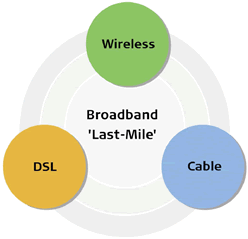Project Overview
Goals
- To form an organization that acts as a catalyst between municipalities and private citizens to foster community growth.
- To develop a technology platform that supports new (and enhances existing) Internet Protocol (IP)services within underserved communities.
- To minimize the expense of deploying and maintaining essential telecommunications services such as: IP telephony, public safety/security and general Internet access.
- To provide subsidized services to improve the prospects of existing or new community businesses.
- To mix business and community experience with common sense and a positive attitude, to help find ways to move high-need communities forward.

Analysis
The Obama administration announced its commitment to extend broadband access to underserved urban and rural communities across the nation. The reality is that given the current economic climate where the country faces financial burdens of unprecedented proportions - government spending on a strict priority basis is inevitable. So the question is - how much of a priority will providing broadband access to underserved communities be?
If broadband expansion proves to be costly and time-consuming, then it is likely that other more pressing issues will supercede this plan. The president described broadband deployment as "laying broadband lines" throughout communities. However, the cost of laying new land lines - whether it is copper, co-axial or (ideally) fiber - is enormous due to:
- Length of time required for deployment (community disruption).
- Personnel costs (large staffing requirements ovr an extended period).
- Capital costs of physical installation (transporting, trenching, pulling cable, connecting, etc.).
With the economy in a steep downturn, it is no longer enough for city or county management to passively wait for the current administration to extend affordable broadband access to their community. They must play an active role in defining the future of their municipalities by submitting a cohesive plan to the federal agency in charge of broadband expansion.
The successful plan will require:
- The agility to effectively shift the deployment model for leaner times.
- Optimization and innovation to wring out needless expenses.
- Reducing costs by co-creating offerings collaboratively and sharing resources with private and public partners.
- Minimize network deployment, operation and maintenance by taking a smart approach to broadband technology.
Technology Selection

The first task is selecting the ideal broadband technology. It's a tough order to fill. Consumers and businesses demand more and more bandwidth and tolerate fewer service interruptions. Settling on a particular broadband technology is difficult, where the "next big thing" can be yesterday's news before it even hits the streets. The sheer number of choices are mind-boggling - never mind the technology itself.
The network requirements common to all broadband technologies are:
- The ability to support modern voice, data and multimedia communications over a diverse topology.
- The ability to extend existing networks and create new ones quickly, economically with minimal infrastructure requirements.
- The ability to deliver carrier-class quality and reliability with minimal maintenance requirements.
- The ability to support mobile data and voice devices.
- The ability to support low-cost customer premises equipment (CPE).
- The ability to instantly connect subscribers ('on-the-spot' demo capability).
- The ability to be cost competitive with all other available access technologies.
Wireless Solution
Wireless broadband access technology meets all the criteria listed above. The bandwidth provided by this type of link is very much on a par with the dark fiber and allows the IT operators to provide high speed, high quality services to the community, without duplication of data center services. Because there is no provisioning requirement and usually little construction requirements, the time to implementation is usually much shorter than a telco, or dark fiber. Please review the Technology Plan section for more information on the wireless solution.